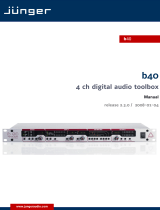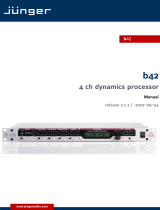
2. FUNCTION DESCRIPTION
FUNCTION DESCRIPTION
B44 is a powerful and flexible audio converter and router combination.
It combines a high quality 4channel A/D- and D/A-converter with a
flexible routing matrix. Together with the optional SDI interface any
kind of audio conversion between analog, digital and embedded audio
is possible.
Any demands regarding sampling rate and word length are to manage
using integrated SRC and dither module.
The combination of the converter box b44 together with the other
toolboxes from b40 series spreads the use of their advanced digital
signal processing also for analog systems. Equipped with the SDI
interface b44 is a versatile crosspoint for analog and digital audio
signals in todays and tomorrrows video production environment.
features
- user friendly and fast recall of routing configurations by using presets
- sophisticated 24 bit ADC and DAC for four channels (44.1 and 48 kHz)
- dithered digital output (24, 20 or 16 bit)
- serial (RS-422) and parallel (GPI) remote capability for switching of presets
- optional: embedded audio processing via SDI-interface incl.
group changing, channel selective audio replacement and relais bypass!
In digital video recording technology four digital audio channels are the
standard configuration. This channel capacity is used increasingly in
production and post-production for surround sound, providing mix
options and for multi-lingual productions.
Quite often it is necessary to make corrections or changes to the audio
which until now required the use of an expensive digital audio mixer.
These tasks can now be easily solved with the Jünger Audio range of
digital audio toolboxes. Simple processing for up to four digital audio
signals may be carried out quickly and efficiently.
Using the SDI versions (SDI=Serial Digital Interface, digital component
video format with 270Mb/s transmission) b40 series can process
embedded audio.
The standard allows up to four groups each of four mono audio
channels. Usually used by most of D-VTR's and other equipment is
Group 1 with 48 kHz synchronous sampling. Synchronous means that
the audio clock is genlocked to the associated video. Each channel can
have up to 20 bits of resolution per audio sample.
The 4-channel processors of b40 series fitted with SDI-interface are
compatibel with the standard SMPTE 272M-AB. They support 48 kHz
synchronous audio sampling with 20 bit word length. Group selection is
possible (see 4.5). The input for the digital audio processing can be
selected between AES/EBU or SDI (serial digital video with embedded
audio). The processed signals are always at both outputs present -
AES/EBU and SDI.
2.1
BASIC
DESCRIPTION
2
2.2
B40SERIES WITH SDI
INTERFACE
operation manual b44, chapter 2 -Function description- page 2-1






























